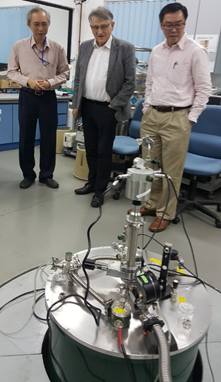Events
A Day with Nobel Laureate Prof. Klaus Von Klitzing
Prof von Klitzing visited NMC and shared his views on quantum standards and SI redefinition
Nobel Laureate Prof Dr Klaus von Klitzing visited NMC on 25 January 2018. He was one of the speakers at the Global Young Scientists Summit (GYSS) - a forum for young researchers from around the world to interact with eminent scientists on scientific & technological solutions to global challenges, which was held in Singapore from 21 to 26 January 2018.
During his stay in Singapore, Prof von Klitzing visited the quantum Hall resistance laboratory in NMC. He shared his views with NMC researchers on the latest developments in metrology with the impending redefinition of the International System of Units (the SI), and quantum Hall resistance (QHR) – a primary realisation of electrical resistance based on his discovery. They exchanged views on quantum based electrical standards to meet the upcoming redefinition of the SI units and dissemination of the SI units to the industry. Prof von Klitzing was also shown NMC‘s research project in photonic gas sensors for indoor environmental quality. In the Optical Radiation Laboratory, NMC researchers showed Prof von Klitzing the primary optical radiation standard enhanced with extended operating range up to 1550 nm by using a new device developed by NMC. With this new device, NMC can directly calibrate the spectral responsivity at wavelengths up to 1550 nm with improved the uncertainty by using the primary standard. NMC has had a fruitful day with Prof Klitzing.

Prof Klaus von Klitzing (centre) visiting NMC’s lab for the realization of quantized Hall resistance in a low temperature cryostat with superconducting magnet.
1985 Nobel Prize in Physics - the Quantum Hall Effect
Prof Dr Klaus von Klitzing discovered the integer quantum Hall effect, for which he was awarded the 1985 Nobel Prize in Physics.
In the early hours of 5 February 1980, while doing an experiment at the High Magnetic Field Laboratory in Grenoble, France, to study the fundamental questions in the electronic transport of silicon field effect transistors, Prof von Klitzing observed that the Hall resistance, the ratio of the measured Hall voltage to the current through the semiconductor sample, exhibited distinct staircase plateaus as a function of the strength of the magnetic field applied normal to the device, and the resistance value depends exclusively on the fundamental constant h/e2 ≈ 25.8 kΩ.
“(It was) An unexpected discovery”, said Prof von Klitzing during his visit at NMC. Nevertheless, the profound discovery provided the world a mean to realise a measurement standard that depends solely on the fundamental physical phenomenon of nature that is highly reproducible, making such quantum standards ideal for the realisation of measurement units. This is unlike artifact standards whose values are often affected by many factors, such as materials and the environment, and tend to change with time.
Realizing the importance of his discovery, Prof von Klitzing submitted a manuscript entitled “Realisation of a Resistance Standard Based on Natural Constants” to Physical Review Letters in May of 1980. The paper was first rejected. Undeterred, Prof von Klitzing gave a talk at the Conference on Precision Electromagnetic Measurement (CPEM’80) on the topic, and a paper with the modified title of “New Method for High-Accuracy Determination of the Fine-Structure Constant Based on Quantized Hall Resistance” – the first paper on quantum Hall effect – was finally accepted for publication on 11 August 1980. For the discovery of the quantum Hall effect, Prof von Klitzing was honoured in 1985 with the Nobel Prize in Physics.
A*STAR celebrates International Women's Day

From groundbreaking discoveries to cutting-edge research, our researchers are empowering the next generation of female science, technology, engineering and mathematics (STEM) leaders.
Get inspired by our #WomeninSTEM
